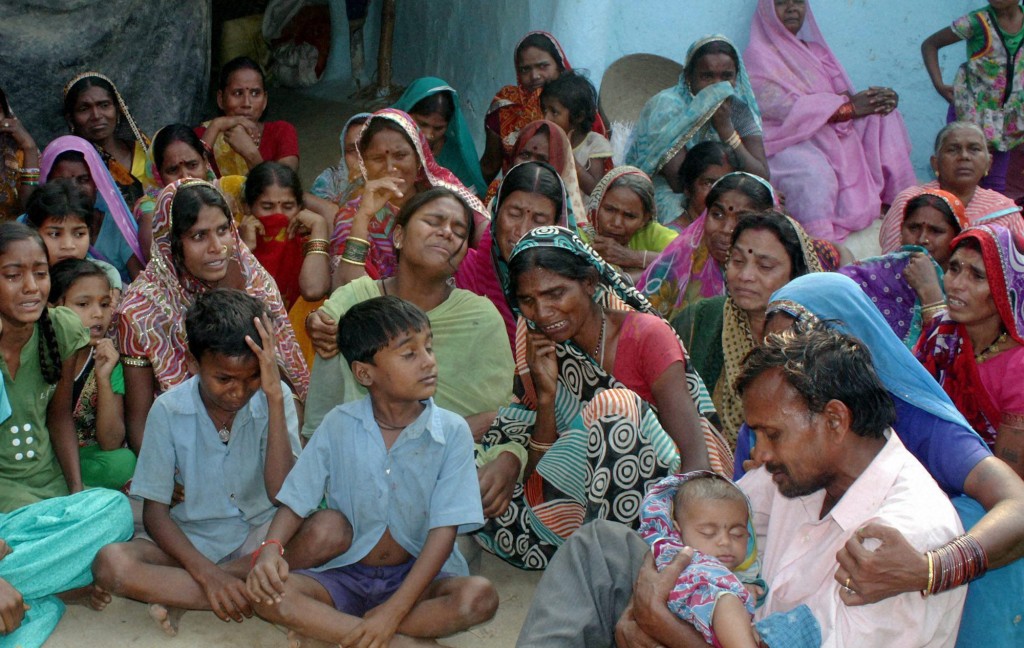- California Assembly OKs highest minimum wage in nation
- S. Korea unveils first graphic cigarette warnings
- US joins with South Korea, Japan in bid to deter North Korea
- LPGA golfer Chun In-gee finally back in action
- S. Korea won’t be top seed in final World Cup qualification round
- US men’s soccer misses 2nd straight Olympics
- US back on track in qualifying with 4-0 win over Guatemala
- High-intensity workout injuries spawn cottage industry
- CDC expands range of Zika mosquitoes into parts of Northeast
- Who knew? ‘The Walking Dead’ is helping families connect
Sterilization drive leaves 11 Indian women dead

Relatives mourn the death of women who died after undergoing sterilization surgeries, at a village near Bilaspur, in the central Indian state of Chhattisgarh, Tuesday, Nov. 11, 2014. Eight Indian women have died and more than a dozen others in critical condition Tuesday after undergoing sterilization surgeries in a free government-run program to help slow the country’s population growth. A total of 83 women, all poor villagers under the age of 32, had the operations Saturday in a hospital outside Bilaspur city. Each of the women had received a payment of 600 rupees, or about $10, to participate in the program, said the state’s chief medical officer, Dr. S.K. Mandal. (AP Photo/Press Trust of India)
NEW DELHI (AP) — 11 Indian women have died and 20 others were in critical condition Tuesday after undergoing sterilization surgeries in a free government-run program to help slow the country’s population growth.
A total of 83 women, all poor villagers under the age of 32, had the operations Saturday in a hospital outside Bilaspur city in the central state of Chhattisgarh. All 83 surgeries were conducted within six hours, said the state’s chief medical officer, Dr. S.K. Mandal.
“That is not usual,” he said, but declined to comment further on what might have gone wrong until autopsies are conducted on the victims.
Each of the women had received a payment of 600 rupees, or about $10, to participate in the program, Mandal said.
The women were sent home Saturday evening after their surgeries, but more than two dozen were later rushed in ambulances to private hospitals after becoming ill. By Tuesday, 11 had died — apparently from either blood poisoning or hemorrhagic shock, which occurs when a person has lost too much blood, state deputy health director Amar Singh told the Press Trust of India news agency.
Twenty other women were in critical care, according to the district magistrate, Siddharth Komal Pardeshi.
“Their condition is very serious. Blood pressure is low,” said Dr. Ramesh Murty at CIMS hospital, one of the facilities where the sick women were taken. “We are now concentrating on treating them, not on what caused this.”
The state suspended four government doctors, including the surgeon who performed the operations and the district’s chief medical officer. It also will give compensation payments of about $6,600 to each of the victims’ families.
Chhattisgarh Chief Minister Raman Singh said “it appears the incident occurred due to negligence” by doctors.
Prime Minister Narendra Modi said in Myanmar, where he was on an official visit, that he had spoken with Singh and urged a thorough investigation.
The state’s surgeons met Tuesday night to discuss whether to continue the state’s sterilization schedule, with a target of 180,000 for the year ending in March set by the central government, Mandal said. He said the quota for Bilaspur district for the year was around 12,000.
A spokeswoman for the federal Health Ministry declined to confirm whether the central government was setting sterilization quotas. India’s central government had said it stopped setting targets for sterilizing women in the 1990s.
Activists blame sterilization quotas for leading health authorities to pressure patients into surgery rather than advising them on other forms of contraception.
“These women have become victims because of the target-based approach to population control,” said Brinda Karat of the All India Democratic Women’s Association, while demanding that the state’s health minister resign.
India’s government — long concerned about rapid growth in a country whose population has reached 1.3 billion — offers free sterilizations to both women and men who want to avoid the risk and cost of having a baby, though the vast majority of patients are women.
In many cases, they are offered a one-time payment for undergoing surgery of $10-$20, or about a week’s pay for a poor person in India. Hundreds of millions of Indians live in poverty.
India has one of the world’s highest rates of sterilization among women, with about 37 percent undergoing such operations compared to 29 percent in China, according to 2006 statistics reported by the United Nations. During 2011-12, the government said 4.6 million Indian women were sterilized.












![일본 사도광산 [서경덕 교수 제공. 재판매 및 DB 금지]](http://www.koreatimesus.com/wp-content/uploads/2024/07/PYH2024072610800050400_P4-copy-120x134.jpg)


